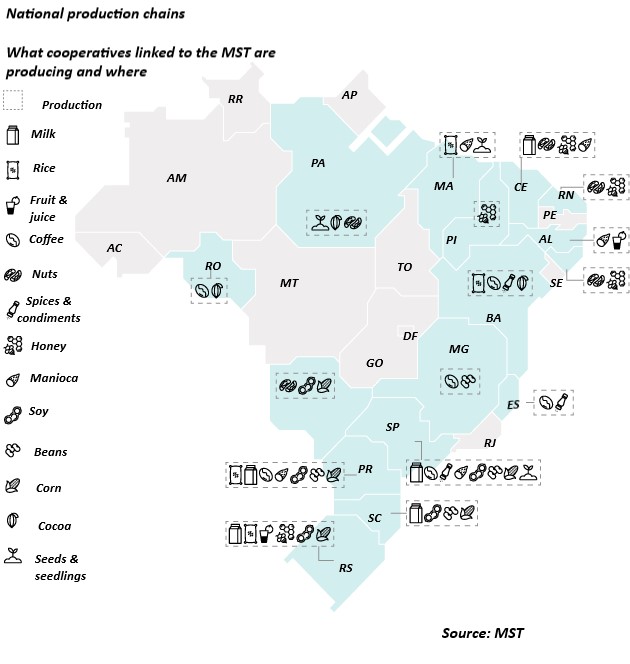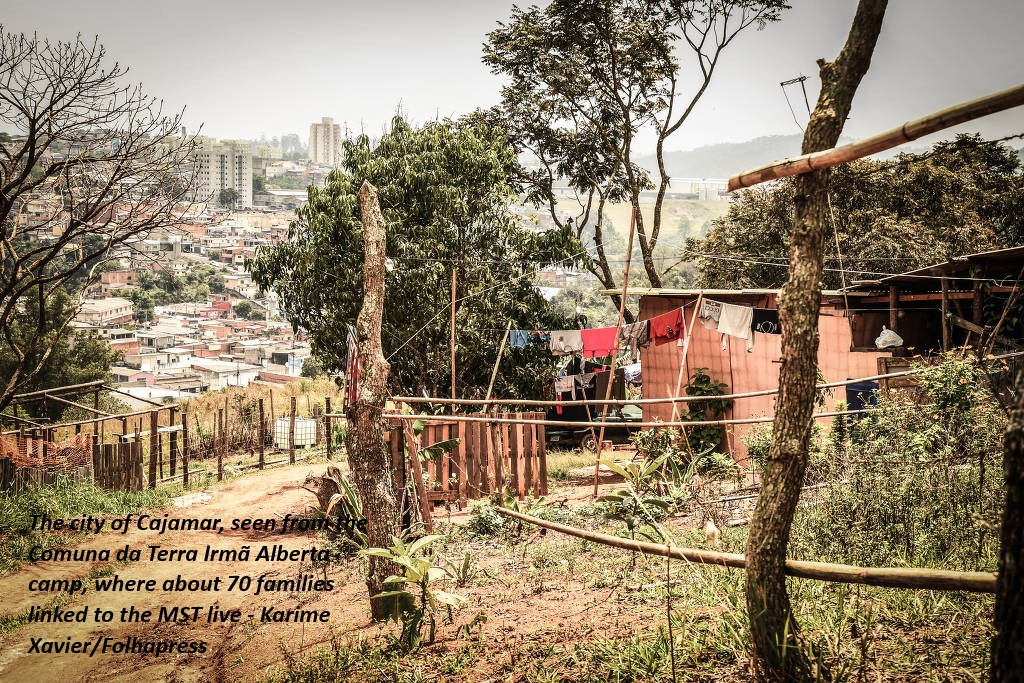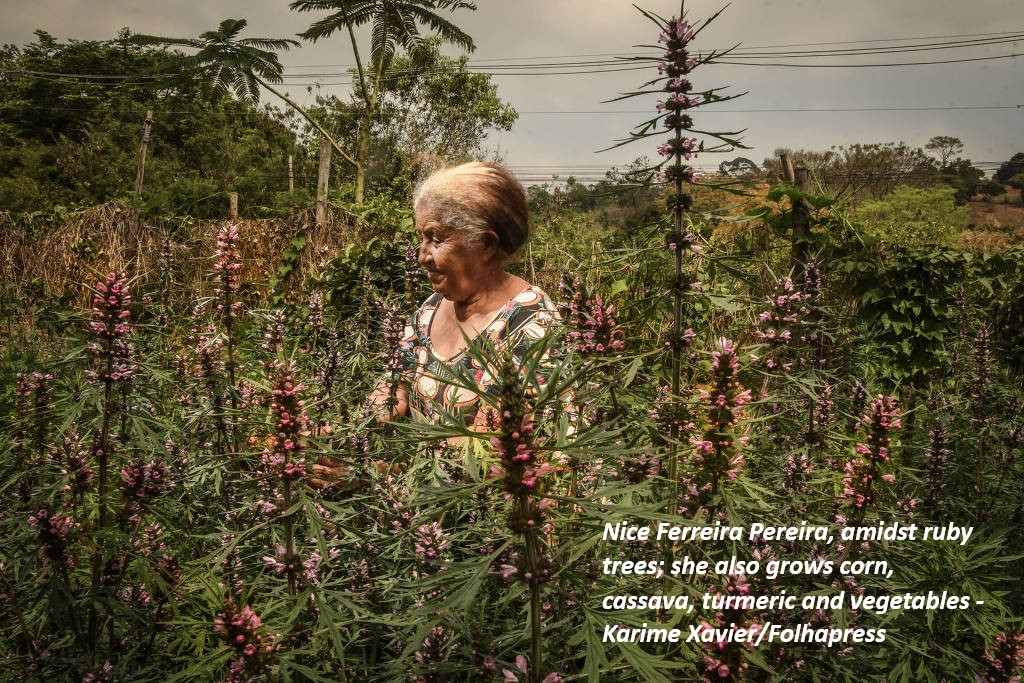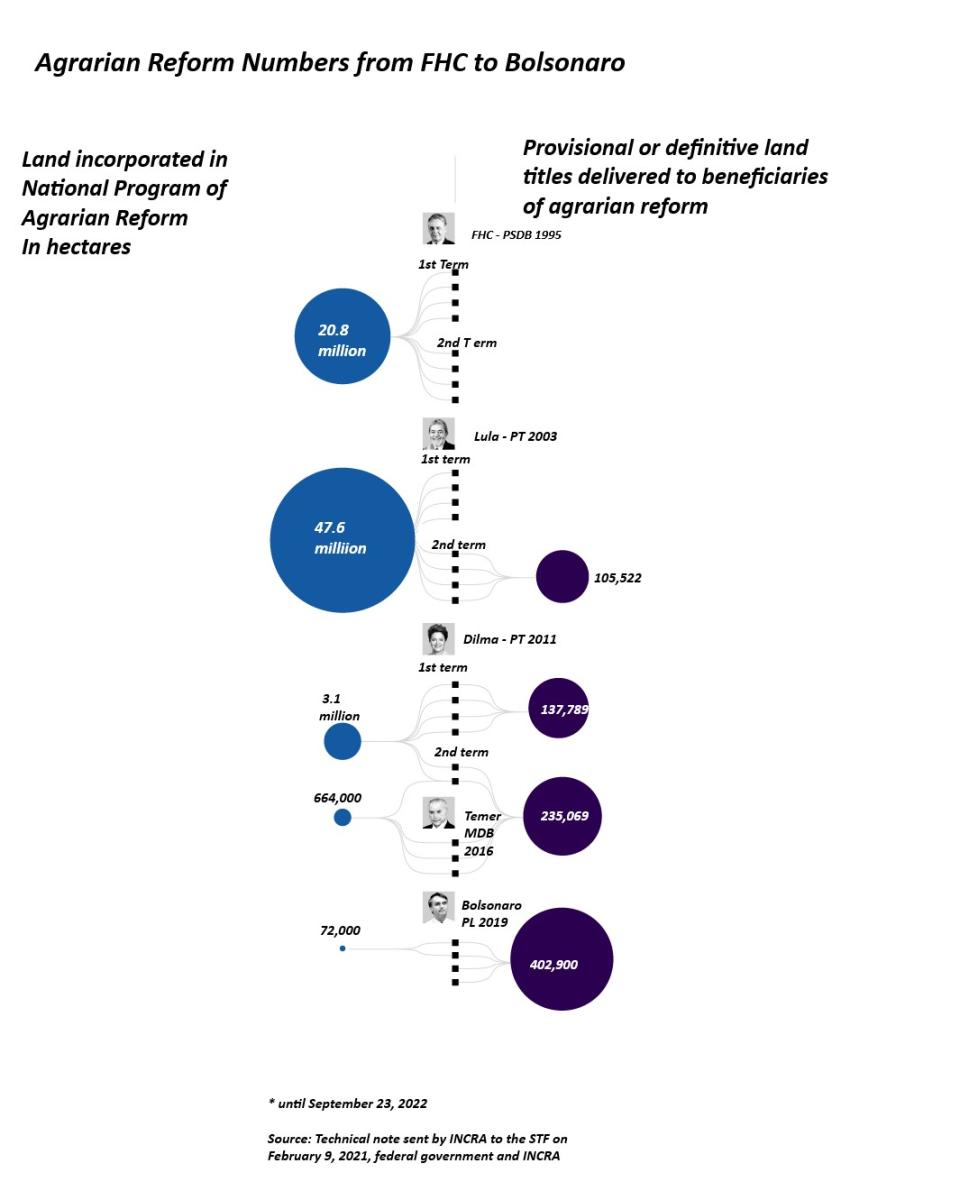MST undergoes 'rebranding' and approaches cities and the middle class
[NOTE: This section usually focusses on the work of FMST. We thought that this article from a mainstream newspaper shows how the view of the MST has changed over time.]
Movement focuses efforts on flags such as agroecology and seeks to gain scale in production
Whoever walks through streets, squares and shops in downtown São Paulo will hardly escape finding someone wearing red caps with an already well-known image: a man holding a machete, next to a woman, with the map of Brazil in the background. Despite the distance between the urban conglomerate and the countryside, the piece is the symbol of the Landless Rural Workers Movement, the MST.
The popularization of the cap reflects a change in strategy that has intensified in the last ten years, with the movement focusing its efforts on food production, on the banner of agroecology and on bringing cities and the middle classes closer together. Even the cap gained other colors, such as black, green, beige and with the rainbow of the LGBT+ flag.
"The rich have always hated us and that is not going to change. The middle class was against us, but now they are in favor. We took the middle class for agroecology, rice, Bela Gil," says João Pedro Stédile, leader and one of the founders of the MST. Agroecology provides a model of sustainable agriculture, without the use of pesticides or herbicides, and that preserves the environment.

The MST today:
450,000 settled families 90,000 encamped families
On the day that Stédile spoke to Folha, chef Bela Gil, known for her natural cuisine, was the master of ceremonies at a meeting held by former President Luiz Inácio Lula da Silva (PT), campaigning for the Presidency of the Republic, with cooperatives.
"The MST has been updating its program permanently, however, since 2014, there has been an inflection, a greater political will due to changes in capitalism, agriculture and, above all, environmental crimes," says Stédile.
In this update, food production for the city gains space on the agrarian reform agenda, with the incorporation of agroecology and agro-industry. "It's not just that the MST has changed. Needs and solutions have changed."
There are now 160 cooperatives under the banner of the movement producing food. The sector leader in the MST, Daniel Mancio, estimates that 25% to 30% of the production of the settlements and encampments is organized in cooperatives.
The rest comes from smaller nuclei, which end up selling their production to middlemen, who will then be responsible for processing and industrialization. About these, the MST cannot calculate how much is being produced.
The type of production varies according to the region of the country, but the main ones (and which already manage to gain some market scale) are rice, beans, corn, wheat, coffee, cocoa, honey, cassava, milk, meat and vegetables.
Mancio says that the organization of production chains allows producers to have more control of the stages and to be able to add value, generating more income for families and internal work. It also allows the movement to communicate with the consumer.

Organic rice produced in Rio Grande do Sul, for example, is distributed to points of sale under the Terra Livre brand, created to sell the various products of 19 settler cooperatives.
Rice production by the MST ranges from 20,000 to 25,000 tons per year (organic rice was around 15,000 tons this year, due to drought; total rice production by the movement is 45,000 tons).
Even if production follows agroecological principles, with the use of bio-inputs and the management of water and forests, classification as organic depends on certification.
This is the case with cocoa produced in the south of Bahia —about 30,000 arrobas [an arroba is about 15 kilograms] a year—, which follows the cabruca [organic producers cooperatives] system, when the trees are planted in the middle of the forest. There are around 2,600 hectares of production, but there is no organic seal.
In Greater São Paulo, the production of the Terra e Liberdade cooperative is distributed in three areas: the Sister Alberta Commune and the Dom Thomás Balduíno settlements, in Franco da Rocha, and Dom Pedro Casaldáliga, in Cajamar. Together, in 2022 they sold about 8 tons of vegetables, 12 tons of fruit, 21,200 plants or bundles of leaves and 8,400 bundles of spices.

Raul de Almeida Miranda, director of the production sector in Greater SP, says that not everyone sells their production through the cooperative. There are those who produce only for their own consumption or make direct sales.
Iranice Ferreira Pereira, 76, says that one of the stars of the fields she keeps with her brother, Lázaro Ferreira, 63, is corn. In January, when the harvest begins, the grain is disputed by the neighborhood. "People even come from Barueri to buy at the fence. There's not enough left for the cooperative."
The rural producer attributes the success to the use of native seeds, as non-genetically modified grains are called. "You eat corn in São Paulo and it doesn't taste like anything. You have to fill it with butter to taste something. In my corn, no, it's even sweet."
Nice, as she is known, lives and produces in the Commune of Terra Sister Alberta, an area of 116 hectares in a region coveted by real estate developers. Near kilometer 28 of the Anhanguera highway, the camp is located in the neighborhood of Perus, on the capital's border with Cajamar and Santana de Parnaíba.
The commune follows an occupation model that privileges the fringes of the cities in the production of vegetables, which demand less space, and which are favored by the short distance between the producer and the consumer.

Maria Alves, 69, has been in the area since the occupation. There, she raised her two children, and continues with the daily care of vegetables, vines and spices. She also maintains a selection of pancs (acronym referring to unconventional food plants) and fruits such as blackberries and bananas.
"Here I have an integrated system. I have the fruit trees, the chicken coop, the vegetable garden, the grape plantation," she says, signaling the surroundings of the house.
Although it doesn't look like a camp—the lots are divided and the houses are masonry— Sister Alberta is not a settlement, nor is it in the process of becoming one. Today around one hundred families live in the region, of which 70 are linked to the MST, which occupied the area in 2003.
In articulation with other social movements that worked in Perus, the occupation intended to prevent the land from becoming a sanitary landfill.
The area belongs to Sabesp [a São Paulo state owned waste treatment company]. To Folha, the company stated that it is working for the sale. According to the MST, a process of expropriation was started, but the appraisal value of the land was considered too high. They say they have authorization from the company to stay there.
The irregular situation, however, makes the producers deal with lack of water and difficulties in accessing credit lines.
They are also unable to participate in public notices, through which cooperatives sell their produce to Pnae (National Program for Food in Schools) – 30% of the lunch budget must come from family farming.
The MST calculates to have sold, in 2021, R$ 400 million in products for school meals. According to Stédile, providing lunch is a priority for the MST.
"You take healthy rice all over Brazil and for children," he says. The leader also says that the sale of organic products to the middle class is secondary. "She has the right and it's good that she eats healthy food, but that's not the market for popular agrarian reform."
The cooperative of Grande SP, like others, faces bottlenecks in the flow. The growth of production necessarily passes through the adoption of agro-industry which, according to Miranda, from the MST, would give "shelf time" by allowing, for example, to package fruits and vegetables in a vacuum.
Comuna Irmã Alberta produces vegetables and fruits in São Paulo, on the border with Cajamar and Santana de Parnaíba (Photos)
The production of the Irmã Alberta commune is sold in São Paulo through consumer groups (which organize themselves in neighborhoods to buy fortnightly or monthly baskets) and through e-commerce.
In the expanded center, the regional itself delivers or drops off at pick-up points, such as Casa do Povo, in Bom Retiro, or at Sol y Sombra, in Bela Vista.
There is also Armazém do Campo, where products from cooperatives from all over Brazil are sold. In Hortifruti [a platform for marketing of frits and vegetables], the maximum distance from the origin is 100 kilometers. The parameter is important to keep the cost of logistics low and not impact the final price, explains Ademar Ludwig, coordinator of the Armazém do Campo chain, which has 20 physical stores and 40 points of sale in the country.
The opening of the first store, in 2016, was a consequence of the weekly organic fair at Água Branca Park, in the west of São Paulo, where cooperatives took their products. Initially, the idea was to have a more "neutral" name, without much association with the MST.
"But since the opening we saw that those who came were supporters. Today our audience also comes from the organic crowd, because of the price", says Ludwig. According to him, the effort is to keep prices competitive in relation to conventional and organic products sold elsewhere.
"Our bananas are always cheaper than those from the sacolão [fruit and vegetable market]. We kept milk at R$6, when the markets charged R$8, R$9." About a thousand items from 200 organized groups are sold in the warehouse units. The plan is to have 150 points by 2025 throughout Brazil.
A kilo of Italian tomatoes, which cost around R$19.98 in an organic store's e-commerce, was found for around R$12.98 in the store supplied by the cooperatives. Carrots, in turn, cost about R$13.80 a kilo, in competition, and R$35, on the Armazém do Campo website.
Armazém do Campo sells products from cooperatives linked to the MST (Photos)
The stores, says the manager, do not aim at net profit. "In our pricing policy, we aim at gross profit for the store to maintain itself, to pay for who is working, water, electricity, rent, security and, of course, the cooperative's part, which is the main meaning. , is the settlement."
In the assessment of psychologist Cecília Russo Troiano, who works with brand management, the MST underwent a kind of repositioning.
"Food is a very symbolic exchange, with a lot of affection", she says. "There is a middle class that still feels threatened, but, at the same time, food is a sensitive cause for this same group. Cooperatives have gained evidence."
The MST's work with agroecology and even funding in the financial market may, according to her, have helped to arouse the interest of a public that, until then, had only the memory of a movement of aggressive tactics. "They showed their social contribution and people were able to see this other side that maybe had been eclipsed."
MST goes to the financial market again to raise funds
Another bet of the movement is the financial market. In September 2021, seven cooperatives raised funds through the issuance of CRAs (Agricultural Receivables Certificates), in an operation considered emblematic.
Two new ones are being modelled, according to João Paulo Pacífico, president of Gaia Impacto, responsible for the 2021 funding, and another, in 2020, open only to qualified investors.
For Pacífico, the number of investors interested reflects the change in the way the financial market sees the MST, as well as the existence of a middle class interested in social causes. "More than 5,000 people were interested," says Pacífico. Of these, about 1,500 were able to apply for certificates.
R$ 17.5 million were raised to expand the cooperatives' agro-industry structure, such as processing machines, sealers and packaging machines.
The investment aims to solve a bottleneck in the growth of the processing and processing capacity of what is produced in the settlements.
Pacifico says he has had only good experiences working with cooperatives linked to the MST.
"In eight years of financing traditional agribusiness, I had numerous problems, from large farmers in [Brazil’s] Midwest to coffee trading companies acting in bad faith," he says. "With family farming, there is no bad faith. If he doesn't pay, he knows he can't get any more money."
In the investor's opinion, despite the movement's public image having improved, there is still a lot of prejudice for what he considers to be a consequence of "too much narrative, too much propaganda." "The ones who produce food in Brazil are the MST and family farming. Agribusiness produces commodities for export."

MST as an electoral weapon
The characterization of the MST as a violent land invader is a frequent speech by President Jair Bolsonaro (PL), campaigning for reelection, since before taking over the Planalto.
"Before, during the Lula and Dilma administrations, the MST made land a reason for invasion, fights and death," says the narrator of an electoral propaganda produced by the coalition headed by the president. In the background, images of a tractor destroying orange trees.
In the early 2010s, the MST invaded the Santo Henrique farm, which produced oranges for Cutrale, at least five times. The property area was, according to INCRA [National Institute for Agrarian Reform], public.
"With Bolsonaro, the land is a reason for life, work and pride," completes the electoral propaganda.
Lula was also provoked, more than once, to answer about the PT's proximity to the movement. In Jornal Nacional, he said that "that MST of 30 years ago no longer exists" and praised the group's work in food production when asked what role the movement would have in his government.
The MST defends land occupations and rejects the slander of an invader. More than a semantic issue, the choice of the word embodies a political position, in which it is understood that there is a right to take possession of these areas.
"Who is invading land today? In the conception of the word, of going there, usurping to get rich? It's the farmers who are invading public land, invading indigenous land. This business of saying that the MST invades is already a half-worn speech. Who is invading is not us,” says João Pedro Stédile, one of the founders of the movement.
INCRA says it does not monitor invasions of properties or rural properties. According to a report by the Pastoral Land Commission on conflicts in the countryside, 50 land occupations or repossessions were recorded in Brazil in 2021 and three encampments. Almost ten years earlier, in 2012, there were 255 occurrences, and 15 camps. The survey does not detail these occupations by movement or state.
For the MST, the occupation or invasion of properties is an instrument of political pressure to enforce legislation. The Federal Constitution provides for the expropriation of land for agrarian reform of "rural property that is not fulfilling its social function" - these are unproductive lands.
The update in the MST's positioning, with the approach of urban areas, also has effects on this search for rural areas. Stédile says that in an eventual Lula government [the second round of elections will be on October 30], there will be no will need to expropriate so much land.
This will be the novelty," he says. "Because we want it to come closer to the city, so we'll see here in Greater SP which are the unproductive areas, the government goes there and buys."
